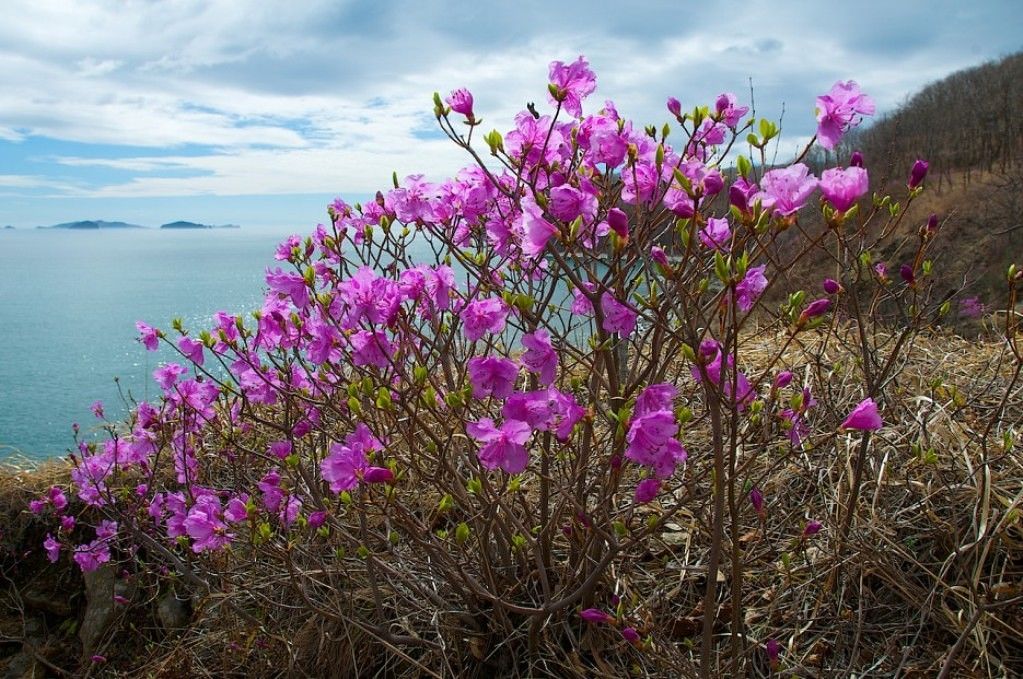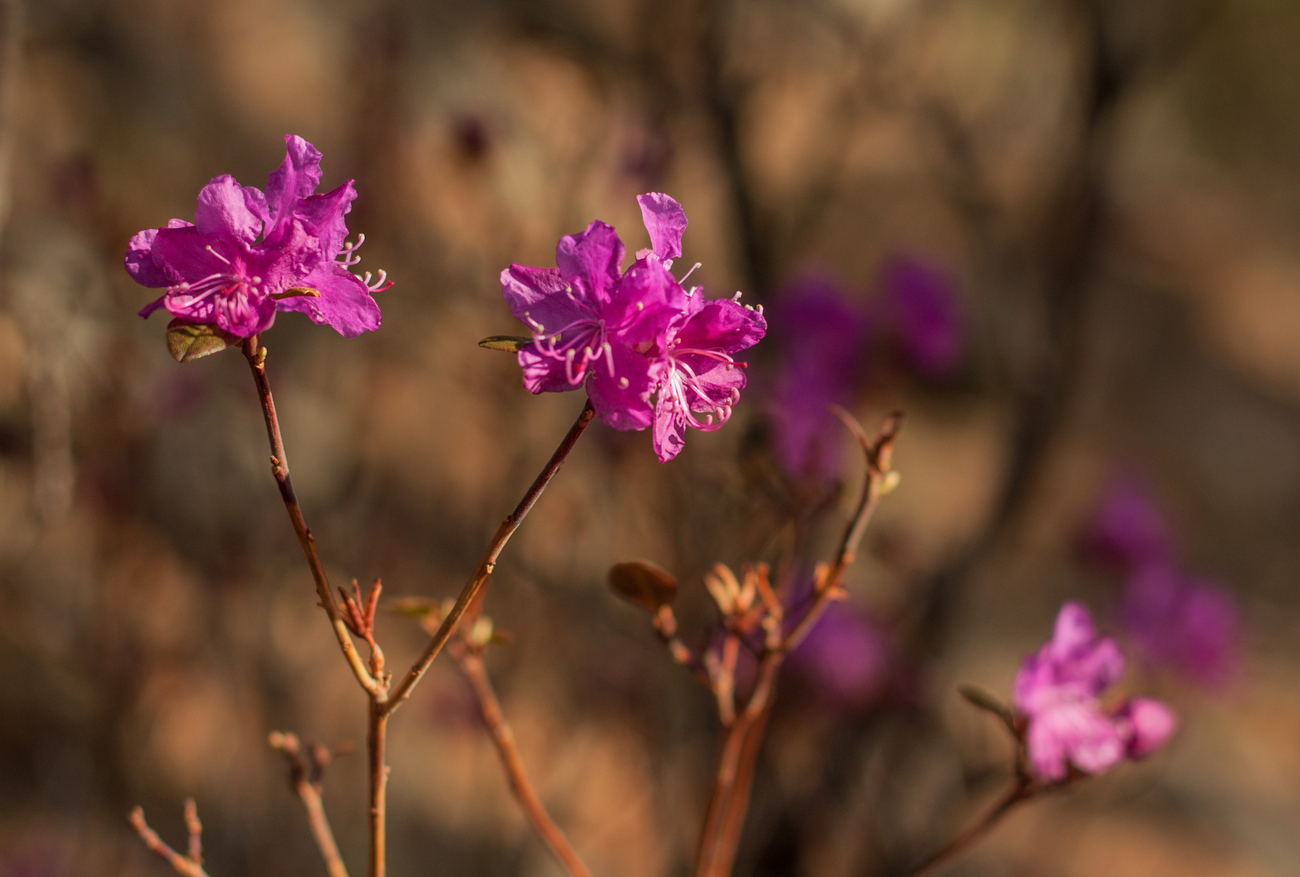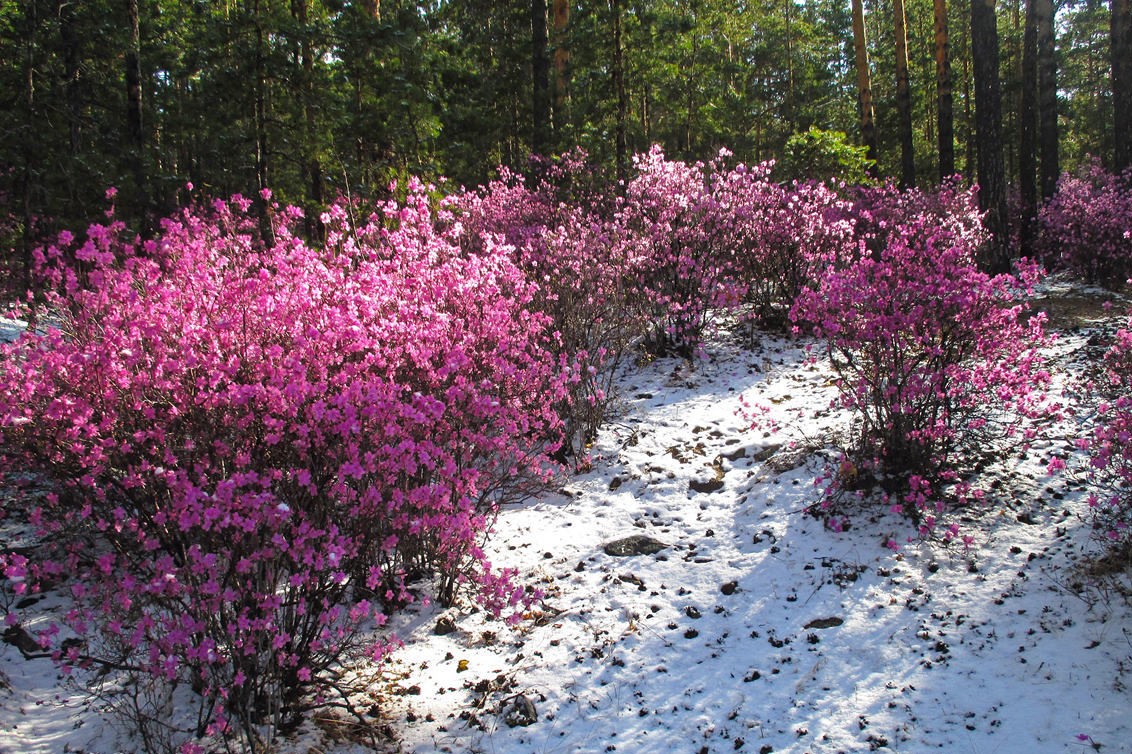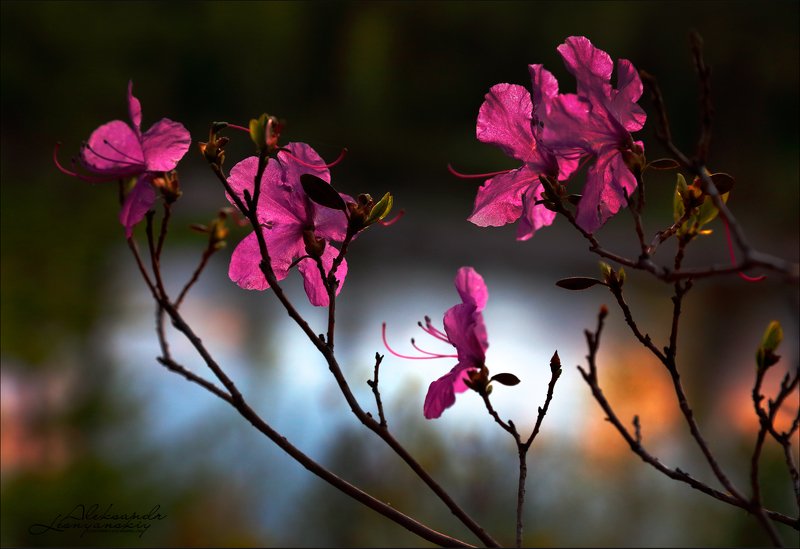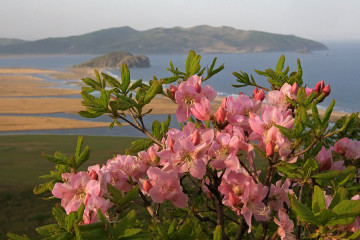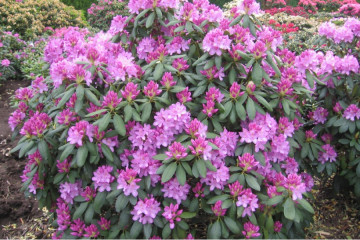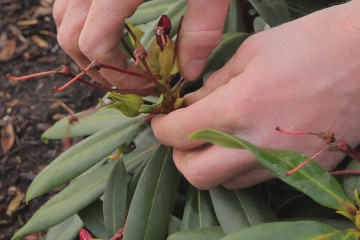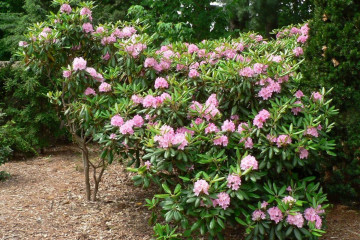Far Eastern rhododendron daurian
Content:
One of the optimal plants for location on a site in Central Russia is the Daurian rhododendron. This very unpretentious perennial plant will delight you with its extraordinary flowering and delicious aroma for many years.
Biological description
Rhododendron Daurian (in Latin Rhododendron Dauricu) grows in Asia and east of the Altai Mountains. Its distribution area includes Transbaikalia, the eastern part of Siberia, the Far East, Sakhalin, Korea, Japan, Manchuria and Northeastern China, where it grows both as separate bushes and thickets.
The plant is a shrub, consisting of 20-50 branch shoots with a dark brown color. Young shoots are thin and elastic, then they completely woody. The height of the shrub ranges from 1.5-2 m, the life expectancy is up to 50 years.
Far Eastern rhododendron (the name reflects the main distribution area) is notable for the fact that at first flowers appear on it: on the tops of the shoots there are from one to three buds, mostly pink, lilac and lilac shades, sometimes white. And only after their flowering - from mid-April to the end of June - the plant produces medium-sized leaves from 1 to 4 cm long and up to 1 cm wide oval in shape with rounding at the ends. Their color differs from the side of the leaf: the upper part is dark green and smooth, and the lower part is paler with a scaly structure.
As a result of flowering, a fruit box is formed. The root system of the shrub is wide and shallow; in the wild, it prefers to propagate by roots, occasionally by seeds.
The chemical composition of rhododendron
The plant is quite toxic, the aroma of its flowers, when inhaled for a long time, can cause nausea and headache, honey from the flowers of the plant in large quantities can cause hallucinations, and the leaves contain andromedotoxin - a substance with a narcotic effect that can first excite the nervous system, and then significantly inhibit it. upsetting heart activity. Also, rhododendron contains a large amount of essential oil, both in leaves and flowers.
Beneficial features
In moderation and as prescribed by a doctor, rhododendron preparations have the following properties:
- bactericidal;
- antipyretic;
- pain reliever;
- calming;
- diaphoretic.
This proves once again that everything is good in moderation, and even poisons have healing properties. With the help of this plant, they get rid of shortness of breath and edema, it improves cardiac activity, lowers blood pressure.
Rhododendron leaves are used in the treatment of rheumatism, epilepsy, colitis and colds, as well as chronic bronchitis and some other diseases. Tea made from the leaves of the plant can help relieve headaches and sore throat, as well as relieve coughing up phlegm.
Contraindications to the use of drugs from wild rosemary are heart disease, pregnancy, lactation, and renal dysfunction.
Seed propagation
Gardeners who want to grow such bushes from seeds are faced with a rather time-consuming process that requires vigilant control. It is best to start in late February - early March. It is necessary to prepare the soil - a peat-sand mixture in a 1: 1 ratio, which needs preliminary disinfection. The soil is poured into the container without tamping or moistening. Pour wild rosemary seeds on top.
Watering is carried out through the pallet until the soil is completely moistened, excess moisture is removed. Sowing is covered with foil or glass. The first shoots will appear in 3 weeks at room temperature.
After the emergence of seedlings, the film is removed, and the plants are moved to a room with a temperature of 8-12 ° C. Seedlings are provided with good lighting, but avoiding direct sunlight. Care must be taken to keep the substrate constantly moist. Then you should gradually accustom the plants to fresh air.
Young rhododendrons dive in June, planting them in large boxes with a distance of 1.5 cm. Staying plants outdoors in summer is encouraged. With the onset of the first cold weather, young wild rosemary is brought into a room with a temperature of 8-18 ° C, while it is worth providing them with 12-16 hour daylight hours throughout the winter.
In late February - early March, the plants are transplanted again already at a distance of 3-4 cm from each other. The soil should be constantly moist, but in the second year of life of rhododendrons, they begin to make mineral fertilizing. For the summer they should be sent back to the garden.
In the third year, the seedlings are planted in prepared beds in the open field, not forgetting about watering and fertilizing, and they are transplanted to a permanent place only for 4-5 years.
Propagation by cuttings
In contrast to the method of growing from seeds, propagation by cuttings is a much simpler and less energy-intensive method. Cuttings are prepared only in the first half of summer. Semi-lignified and strong shoots are chosen and at an angle of 45 ° they cut off the apical part of at least 10 cm and no more than 15 cm in length. The lower leaves are removed and the cuttings are soaked in a growth promoter.
Then the cutting is placed in the prepared soil at an angle of 30 °, deepening it and squeezing it with earth. Then watering is carried out and covered with a cap made of film or other improvised means on top.
For successful rooting, it is necessary to maintain a temperature of 25-30 ° C and increase daylight hours to 14-16 hours. After three months, roots should appear.
Young rhododendrons from cuttings are grown for a year or two in boxes, observing watering, feeding and temperature conditions, as in the case of germination from seeds, and then planted in a permanent place of residence.
Root layers
Rhododendron, or wild rosemary, can also be propagated by layering. This procedure is carried out in the spring. The shoots closest to the ground are chosen from the bush, no more than 5 pcs. from one bush. At the point of contact with the soil on the branch, a longitudinal cut is made, inserting a chip into it so that it does not close.
Next, a hole is made about 15 by 15 cm in size, in which the shoot is fixed with a bracket. The hole is covered with acidic soil and mulched with peat, and the rest of the shoot is tied up so that it looks up. All that remains is to maintain soil moisture and not rush. Already next year, the plant will be ready to give new shoots.
Dividing the bush
This method is used when transplanting a shrub: it is necessary to be extremely careful (the roots are very fragile and thin) to divide the bush into several parts, preserving the root system. Further actions will be the same as in other cases.
Shrub planting
Planting and caring for Daurian rhododendron requires careful selection of place and accuracy, but in general the plant can be called unpretentious.
Site selection and soil preparation
The place must be chosen especially carefully, since the plant can live up to 50 years and is not too supportive of frequent transplants. Therefore, the optimal location would be a lit area, but not in direct sunlight, protected from the wind. The north side of the site or the neighborhood with conifers is suitable. It is optimal to choose a flat surface where there is no stagnation and accumulation of ground or other waters. The soil should not be heavy or dense, the optimal acid-base balance is from 4.5 to 5.
Pit preparation
It is necessary to apply mineral fertilizer to the soil, and then prepare the pits: their width and depth should be about 60-70 cm.The distance between the bushes varies from plant variety and can be from 70 cm to 2 m.When planting, it is important to monitor the root collar, it should remain above the surface a couple of centimeters.
After planting, the plant is watered and mulched with coniferous needles or peat.
Care
In early spring and after the end of flowering, mineral fertilizers are applied, the soil is not loosened deeply, the weeds must be removed. If there are signs of a lack of moisture, watering is necessary, and it is advisable to maintain a layer of mulch all year round. In the first year after planting, wild rosemary is not allowed to bloom, this allows you to grow a stronger and more developed plant.
If the rhododendron is properly cared for, then it is not very prone to disease. However, at the first sign, the best solution would be to remove all affected shoots and burn, and process the bush depending on the manifestations of the problems.
Ledum is quite frost-hardy and tolerates cold up to -45 ° С. The feasibility of sheltering its root system for the winter is calculated based on the climatic conditions of the growing zone, however, if necessary, standard methods of shelter are used, according to agricultural technology, with a high hillock at the base of the root, leaves and spruce branches. Shoots can be bent to the ground.
Daurian rhododendron is a very beautiful and peculiar plant with spectacular flowers. Culture has beneficial properties and heals many diseases. It can be planted in the northern strip of Russia, as it easily tolerates frost, but requires special care.
